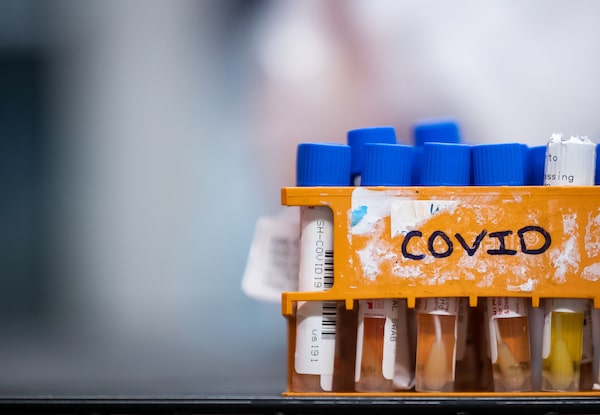
Specimens to be tested for COVID-19 at LifeLabs after being logged upon receipt at the company's lab, in Surrey, B.C., on March 26, 2020.DARRYL DYCK/The Canadian Press
New modelling shows British Columbia is the most severely affected province for COVID infections, health care system impact and death in the country.
According to the “hazard index” published by COVID-19 Resources Canada, a grassroots initiative with the objective of facilitating Canada’s response to the pandemic, B.C. has had the highest score across the country for more than a month.
The index is calculated from current infections and spread, health care system impact and mortality.
Tara Moriarty, an infectious-disease researcher and co-founder of the group, said the high score in B.C. is driven by a combination of first-time infections and the effectiveness of COVID vaccines starting to wane. She added people who were infected early in the Omicron wave have begun to lose antibodies providing protection.
Until the end of 2022, B.C. had not had as many first-time infections as other provinces, she noted. “We’re guessing that as the protective effects of vaccines of the new doses that people had in the fall campaign are starting to wear off that B.C. is starting to catch up in the number of first-time infections.”
The modelling’s hazard index scores are grouped into six ranges, from “low” to “severe.” According to Dr. Moriarty, who is also an associate professor at University of Toronto, they rank as severe when they expect there will be more than 8 per cent excess mortality in the province from infections on that date.
B.C.’s hazed index score, between May 20 and 26, is 13. “It’s at least two times higher than then we would expect over the course of an entire year.”
British Columbia is followed by Prince Edward Island, Newfoundland and Labrador, and Saskatchewan, which are all marked “severe.”
Dr. Moriarty said PEI has a surge of infections around April 9. The province’s infections and hospitalizations are now moderate but the deaths are severe. She suspects that in Saskatchewan, some of the people who are infected in the first period of Omicron are losing the infection-induced protection and are able to get reinfected at this point.
She said based on data from the UK Health Security Agency, new variants such as BQ.1, BQ.1.1 and XBB.1.5 appear to be more able to infect people sooner after vaccination
She said these numbers fluctuate. “But generally, we’re still in a situation where we may not be seeing enormous peaks the way we did back in January and March of 2022. But we are still living in a very high endemic period, where there are times when the situation is quite serious, and there are still a lot of people who are dying from COVID, being hospitalized with COVID.”
Health policy researcher Andrew Longhurst said he’s astonished that officials are acting like there is nothing to be concerned about.
He called the removal of masks in health care and long-term care settings “a massive mistake.” He added that reporting from some jurisdictions such as Britain show hospital-acquired COVID-19 is significant.
He said governments across the country need to start looking at setting indoor air quality standards. Belgium has done so, he noted.
Both experts addressed the importance of governments and health authorities being transparent about COVID data.
“I think that the practice of, for example, not really communicating with the public, or saying that the situation is stable, but without telling people what is actually happening, is pretty problematic,” Dr. Moriarty said.
“People assume that things are okay. … And they make decisions accordingly. And that’s how people end up in hospital and dying.”
Provincial Health Officer Bonnie Henry said in a statement that her team continues to closely monitor the number of lab-confirmed cases of COVID-19, severe illness and hospitalizations because of COVID-19 outbreaks, as well as complete whole genome sequencing on all positive COVID-19 PCR tests and viruses detected through waste water surveillance.
“All indicators stated above have been declining in recent weeks,” reads the statement.
As of Thursday, 162 people are in hospital with COVID-19 and 16 are in intensive care.
“This is the lowest number of people we’ve had in hospital with a positive COVID-19 test in over a year. We are in a much better position now, compared to earlier in the pandemic,” Dr. Henry said.
She said thanks to the high level of population immunity, the virus is no longer causing severe disease in most people, and this is why the public can now move forward with confidence and remove some of the COVID-19 measures that were in place.
Dr. Henry said with regards to the Moriarty lab COVID-19 forecast, neither the Ministry of Health nor the BC Centre for Disease Control were involved in the preparation of the forecast, so it is unclear what metrics or what methodology they used to develop their reporting.
Dr. Moriarty said her group has been using data from the Public Health Agency of Canada.
Dr. Henry said there will still be some situations where masks will be required in health care settings, or situations where they have always been required to protect high-risk patients against respiratory transmitted infections and protect workers against high-risk exposure to infectious diseases.
 Xiao Xu
Xiao Xu